Hao Zhang
refer to the report for detailed contributions
Hierarchical Transformers for Unsupervised 3D Shape Abstraction
Oct 31, 2025Abstract:We introduce HiT, a novel hierarchical neural field representation for 3D shapes that learns general hierarchies in a coarse-to-fine manner across different shape categories in an unsupervised setting. Our key contribution is a hierarchical transformer (HiT), where each level learns parent-child relationships of the tree hierarchy using a compressed codebook. This codebook enables the network to automatically identify common substructures across potentially diverse shape categories. Unlike previous works that constrain the task to a fixed hierarchical structure (e.g., binary), we impose no such restriction, except for limiting the total number of nodes at each tree level. This flexibility allows our method to infer the hierarchical structure directly from data, over multiple shape categories, and representing more general and complex hierarchies than prior approaches. When trained at scale with a reconstruction loss, our model captures meaningful containment relationships between parent and child nodes. We demonstrate its effectiveness through an unsupervised shape segmentation task over all 55 ShapeNet categories, where our method successfully segments shapes into multiple levels of granularity.
Real Deep Research for AI, Robotics and Beyond
Oct 23, 2025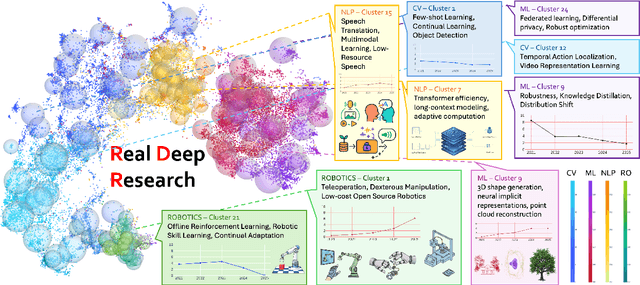
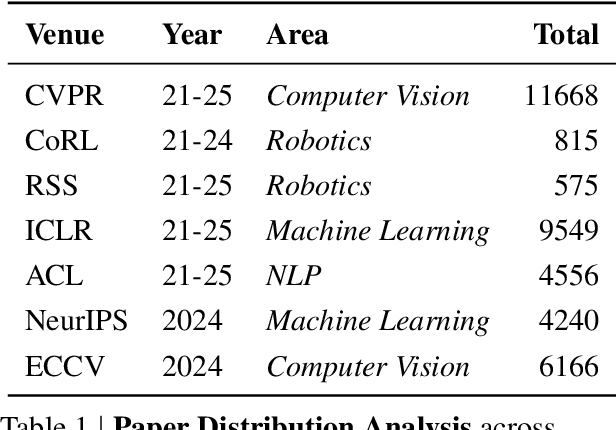

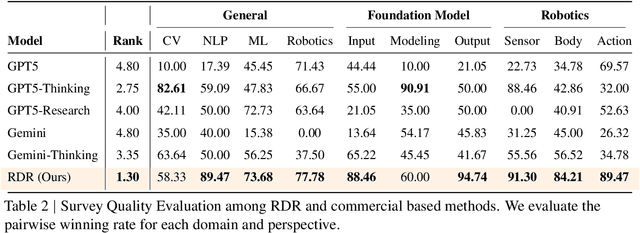
Abstract:With the rapid growth of research in AI and robotics now producing over 10,000 papers annually it has become increasingly difficult for researchers to stay up to date. Fast evolving trends, the rise of interdisciplinary work, and the need to explore domains beyond one's expertise all contribute to this challenge. To address these issues, we propose a generalizable pipeline capable of systematically analyzing any research area: identifying emerging trends, uncovering cross domain opportunities, and offering concrete starting points for new inquiry. In this work, we present Real Deep Research (RDR) a comprehensive framework applied to the domains of AI and robotics, with a particular focus on foundation models and robotics advancements. We also briefly extend our analysis to other areas of science. The main paper details the construction of the RDR pipeline, while the appendix provides extensive results across each analyzed topic. We hope this work sheds light for researchers working in the field of AI and beyond.
Advances in 4D Representation: Geometry, Motion, and Interaction
Oct 22, 2025Abstract:We present a survey on 4D generation and reconstruction, a fast-evolving subfield of computer graphics whose developments have been propelled by recent advances in neural fields, geometric and motion deep learning, as well 3D generative artificial intelligence (GenAI). While our survey is not the first of its kind, we build our coverage of the domain from a unique and distinctive perspective of 4D representations\/}, to model 3D geometry evolving over time while exhibiting motion and interaction. Specifically, instead of offering an exhaustive enumeration of many works, we take a more selective approach by focusing on representative works to highlight both the desirable properties and ensuing challenges of each representation under different computation, application, and data scenarios. The main take-away message we aim to convey to the readers is on how to select and then customize the appropriate 4D representations for their tasks. Organizationally, we separate the 4D representations based on three key pillars: geometry, motion, and interaction. Our discourse will not only encompass the most popular representations of today, such as neural radiance fields (NeRFs) and 3D Gaussian Splatting (3DGS), but also bring attention to relatively under-explored representations in the 4D context, such as structured models and long-range motions. Throughout our survey, we will reprise the role of large language models (LLMs) and video foundational models (VFMs) in a variety of 4D applications, while steering our discussion towards their current limitations and how they can be addressed. We also provide a dedicated coverage on what 4D datasets are currently available, as well as what is lacking, in driving the subfield forward. Project page:https://mingrui-zhao.github.io/4DRep-GMI/
Maritime Communication in Evaporation Duct Environment with Ship Trajectory Optimization
Oct 08, 2025Abstract:In maritime wireless networks, the evaporation duct effect has been known as a preferable condition for long-range transmissions. However, how to effectively utilize the duct effect for efficient communication design is still open for investigation. In this paper, we consider a typical scenario of ship-to-shore data transmission, where a ship collects data from multiple oceanographic buoys, sails from one to another, and transmits the collected data back to a terrestrial base station during its voyage. A novel framework, which exploits priori information of the channel gain map in the presence of evaporation duct, is proposed to minimize the data transmission time and the sailing time by optimizing the ship's trajectory. To this end, a multi-objective optimization problem is formulated and is further solved by a dynamic population PSO-integrated NSGA-II algorithm. Through simulations, it is demonstrated that, compared to the benchmark scheme which ignores useful information of the evaporation duct, the proposed scheme can effectively reduce both the data transmission time and the sailing time.
Towards Interpretable and Inference-Optimal COT Reasoning with Sparse Autoencoder-Guided Generation
Oct 02, 2025



Abstract:We propose a novel method that leverages sparse autoencoders (SAEs) and clustering techniques to analyze the internal token representations of large language models (LLMs) and guide generations in mathematical reasoning tasks. Our approach first trains an SAE to generate sparse vector representations for training tokens, then applies k-means clustering to construct a graph where vertices represent token clusters and weighted edges capture sequential token transitions. Using this graph, we define an edge-weight based reward function to quantify adherence to established reasoning traces, thereby identifying exploitative reasoning trajectories. Additionally, we measure generation diversity from clustering to assess the extent of exploration. Our findings indicate that balancing both exploitation and exploration is crucial for achieving high accuracy in mathematical reasoning tasks. During generation, the SAE can serve as a scalable reward model to guide generations, ensuring a balanced trade-off between exploitation and exploration. This prevents extreme behaviors in either direction, ultimately fostering a higher-quality reasoning process in LLMs.
Distributed Multi-Task Learning for Joint Wireless Signal Enhancement and Recognition
Sep 19, 2025Abstract:Wireless signal recognition (WSR) is crucial in modern and future wireless communication networks since it aims to identify the properties of the received signal in a no-collaborative manner. However, it is challenging to accurately classify signals in low signal-to-noise ratio (SNR) conditions and distributed network settings. In this paper, we propose a novel distributed multi-task learning framework for joint wireless signal enhancement and recognition (WSER), addressing the crucial need for non-collaborative signal identification in modern wireless networks. Our approach integrates a wireless signal enhancement and recognition network (WSERNet) with FedProx+, an enhanced federated learning algorithm designed for heterogeneous data distributions. Specifically, WSERNet leverages an asymmetric convolution block (ACBlock) to capture long-range dependencies in the input signal and improve the performance of the deep learning model. FedProx+ introduces a proximal term to the loss function to encourage the model updates to be closer to the previous model, enhancing the convergence speed and robustness of federated learning. Extensive experiments demonstrate the effectiveness of the proposed framework for joint WSER, achieving superior performance compared to state-of-the-art methods under both centralized and distributed settings including independent and identically distributed (IID) and non-IID data distributions.
* accepted by Transactions on Cognitive Communications and Networking
RGB-Only Supervised Camera Parameter Optimization in Dynamic Scenes
Sep 18, 2025

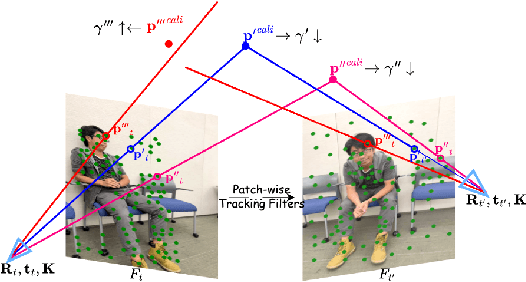
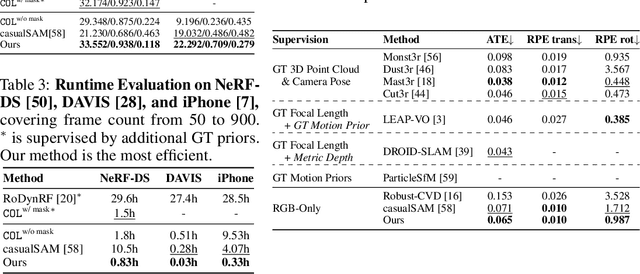
Abstract:Although COLMAP has long remained the predominant method for camera parameter optimization in static scenes, it is constrained by its lengthy runtime and reliance on ground truth (GT) motion masks for application to dynamic scenes. Many efforts attempted to improve it by incorporating more priors as supervision such as GT focal length, motion masks, 3D point clouds, camera poses, and metric depth, which, however, are typically unavailable in casually captured RGB videos. In this paper, we propose a novel method for more accurate and efficient camera parameter optimization in dynamic scenes solely supervised by a single RGB video. Our method consists of three key components: (1) Patch-wise Tracking Filters, to establish robust and maximally sparse hinge-like relations across the RGB video. (2) Outlier-aware Joint Optimization, for efficient camera parameter optimization by adaptive down-weighting of moving outliers, without reliance on motion priors. (3) A Two-stage Optimization Strategy, to enhance stability and optimization speed by a trade-off between the Softplus limits and convex minima in losses. We visually and numerically evaluate our camera estimates. To further validate accuracy, we feed the camera estimates into a 4D reconstruction method and assess the resulting 3D scenes, and rendered 2D RGB and depth maps. We perform experiments on 4 real-world datasets (NeRF-DS, DAVIS, iPhone, and TUM-dynamics) and 1 synthetic dataset (MPI-Sintel), demonstrating that our method estimates camera parameters more efficiently and accurately with a single RGB video as the only supervision.
A Novel Task-Driven Diffusion-Based Policy with Affordance Learning for Generalizable Manipulation of Articulated Objects
Sep 18, 2025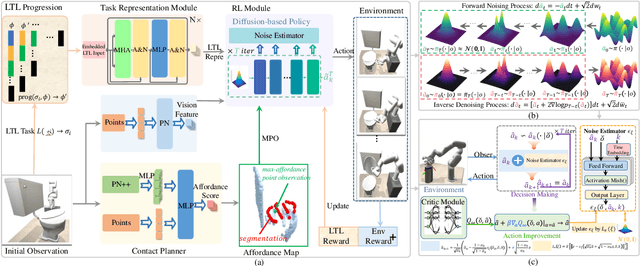
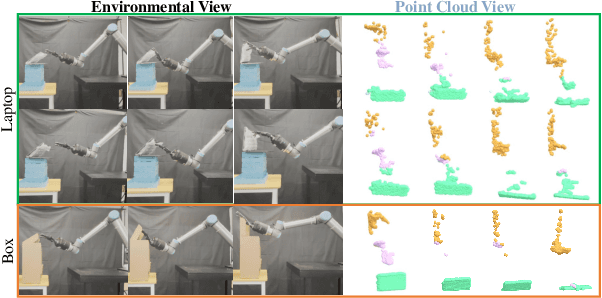

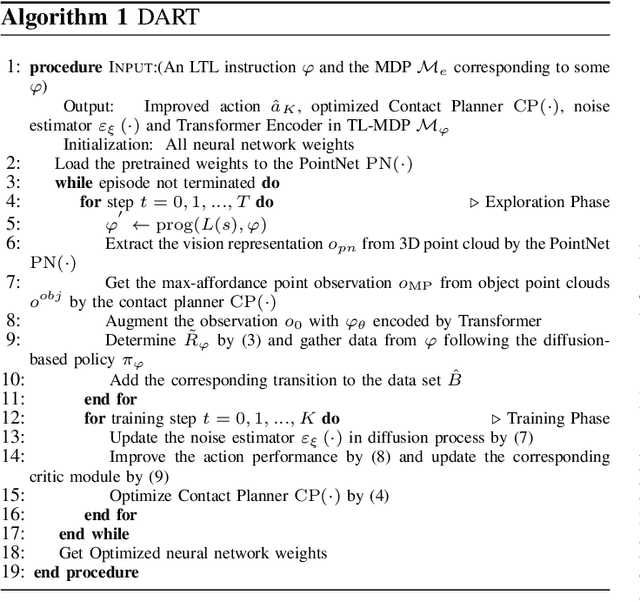
Abstract:Despite recent advances in dexterous manipulations, the manipulation of articulated objects and generalization across different categories remain significant challenges. To address these issues, we introduce DART, a novel framework that enhances a diffusion-based policy with affordance learning and linear temporal logic (LTL) representations to improve the learning efficiency and generalizability of articulated dexterous manipulation. Specifically, DART leverages LTL to understand task semantics and affordance learning to identify optimal interaction points. The {diffusion-based policy} then generalizes these interactions across various categories. Additionally, we exploit an optimization method based on interaction data to refine actions, overcoming the limitations of traditional diffusion policies that typically rely on offline reinforcement learning or learning from demonstrations. Experimental results demonstrate that DART outperforms most existing methods in manipulation ability, generalization performance, transfer reasoning, and robustness. For more information, visit our project website at: https://sites.google.com/view/dart0257/.
Hunyuan3D Studio: End-to-End AI Pipeline for Game-Ready 3D Asset Generation
Sep 16, 2025



Abstract:The creation of high-quality 3D assets, a cornerstone of modern game development, has long been characterized by labor-intensive and specialized workflows. This paper presents Hunyuan3D Studio, an end-to-end AI-powered content creation platform designed to revolutionize the game production pipeline by automating and streamlining the generation of game-ready 3D assets. At its core, Hunyuan3D Studio integrates a suite of advanced neural modules (such as Part-level 3D Generation, Polygon Generation, Semantic UV, etc.) into a cohesive and user-friendly system. This unified framework allows for the rapid transformation of a single concept image or textual description into a fully-realized, production-quality 3D model complete with optimized geometry and high-fidelity PBR textures. We demonstrate that assets generated by Hunyuan3D Studio are not only visually compelling but also adhere to the stringent technical requirements of contemporary game engines, significantly reducing iteration time and lowering the barrier to entry for 3D content creation. By providing a seamless bridge from creative intent to technical asset, Hunyuan3D Studio represents a significant leap forward for AI-assisted workflows in game development and interactive media.
AsyMoE: Leveraging Modal Asymmetry for Enhanced Expert Specialization in Large Vision-Language Models
Sep 16, 2025Abstract:Large Vision-Language Models (LVLMs) have demonstrated impressive performance on multimodal tasks through scaled architectures and extensive training. However, existing Mixture of Experts (MoE) approaches face challenges due to the asymmetry between visual and linguistic processing. Visual information is spatially complete, while language requires maintaining sequential context. As a result, MoE models struggle to balance modality-specific features and cross-modal interactions. Through systematic analysis, we observe that language experts in deeper layers progressively lose contextual grounding and rely more on parametric knowledge rather than utilizing the provided visual and linguistic information. To address this, we propose AsyMoE, a novel architecture that models this asymmetry using three specialized expert groups. We design intra-modality experts for modality-specific processing, hyperbolic inter-modality experts for hierarchical cross-modal interactions, and evidence-priority language experts to suppress parametric biases and maintain contextual grounding. Extensive experiments demonstrate that AsyMoE achieves 26.58% and 15.45% accuracy improvements over vanilla MoE and modality-specific MoE respectively, with 25.45% fewer activated parameters than dense models.
 Add to Chrome
Add to Chrome Add to Firefox
Add to Firefox Add to Edge
Add to Edge